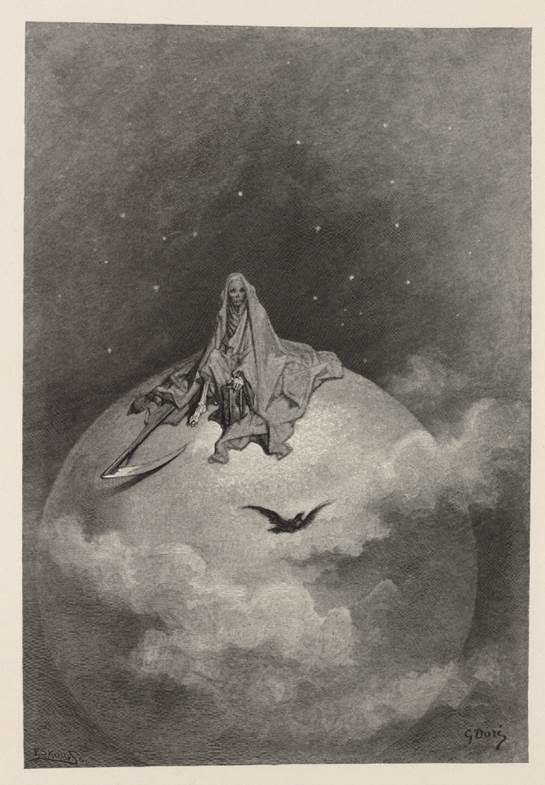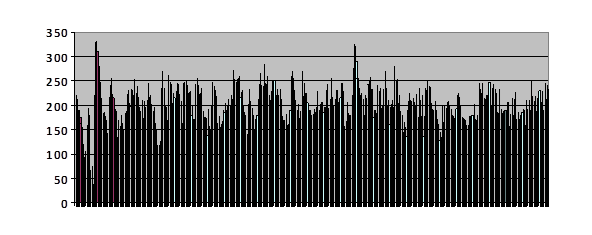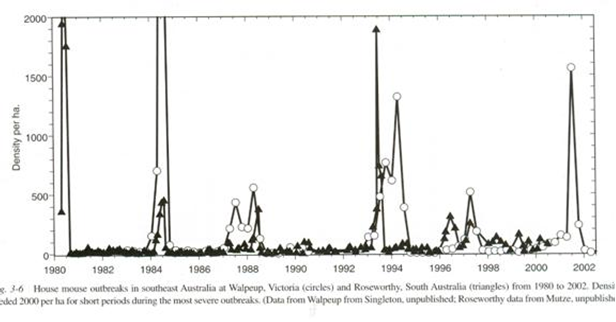Most Dreaded Terror 16 Mouse Plagues

Dore “Raven”
https://hyperallergic.com/102457/rediscovering-the-dark-splendor-of-gustave-dore-with-edgar-allan-poe/ downloaded Feb 18, 2018
It is the 27th of March, 2018. I have written and tested a computer program in C++ language; it took years. I am not good at that kind of work, but it seemed so important that I had to learn the programming language. The capabilities of that language are far more extensive than what I can understand. I think you could write out what I know on a three by five card. Fortunately it proved adequate to the needs of the day.
I’ll go into the program so day in the future, but just to get you acquainted, here is the result of a run in which I simulated both a pre-zygotic process and a post-zygotic process influencing the reproductive rate of a virtual population. It is customary in a movie to assure the audience that no animals were harmed making the movie. I cannot make that claim for computer chips in developing the program. I sit here surrounded by old computers I have burnt out by pushing them beyond their actual (as distinct from advertised) capability.
Here is the run. Each vertical line is a simulated generation with a height which is proportional to the number of offspring in that generation. Each generation offspring were removed at random down to the maximum to which the population was limited. If the number of offspring was less than that limit, none were removed:

The limit was, I think I remember, 100.
I had done a run in which the population was limited to 200, and saved them. Then I pulled 100 out of the recorded virtual individuals and let it run. There was a brief hiccup during which the number fell below 100 followed by a corresponding peak. After that the number varies a great deal – looks very noisy – but I recognize no overall pattern.
Now, quite fortunately, I can offer you some real world data.

G. R. Singleton, C. J. Krebs, “The secret world of wild mice” in The Mouse in Biomedical Research, J. G. Fox, M. T. Davisson, F. W. Quimby, S. W. Barhold, C. E. Newcomer, A. L. Smith, Eds. (Elsever, Burlington, ed. 2, 2007), vol. 1, chap. 3, p. 39.
The book is several volumes long and expensive. Much of it is beyond me, but the chapter by Fox et al. is charming and most helpful. In Australia and New Zealand there are periodically plagues of mice when their numbers increase greatly. They have counting stations where they record mouse numbers. The graph shows counts from a few such stations. Plagues will frequently follow a drought. Numbers rise very high and very fast. At other times the numbers are low and rather stable.
I am not entirely happy with my computer run in a couples of regards. In the simulation, numbers are rather stable but this is because a hard ceiling is in place – a limit to population size. So that proves nothing. The fact that plagues follow droughts suggests that numbers are reduced by a drought leading to the same rebound the computer run shows. But when I look at the mouse data I do not see such a reduction in numbers. Perhaps more frequent counts would have shown it, but I cannot claim evidence here either.
The thing I find exciting is that on two occasions we see a double peak for all the world like the population peaks in the Long House Valley experience. At first glance it may look like there are three such double peaks, but in fact that is the fortuitous juxtaposition of spikes at two different counting stations.
What I cannot explain is why the European voles show the same conspicuous damped oscillation as the laboratory raised fruit flies, the mice here never seem to show such a damped oscillation.
I hope to return to this point and make a suggestion after we have looked at Japanese quail in a future talk.
I shall also return to this graph when we discuss laboratory bred mice.
Perhaps somebody more deft than I can use my source code, available on nobabies.net now and to be discussed also in the future, and give a more plausible demonstration of a stable baseline. But even so, this is a most valuable data set from which I expect to show more about the mechanism of the link between kinship and fertility.
YouTube video script directory
Home page


